How to Use One Lighting Setup for Two Very Different Portraits
One thing that I like to tell photography beginners (and beginners in a lot of things actually) is a well-known but still very true statement: "Keep it simple!" Often beginning photographers will try and buy as much gear and lighting equipment as they can in an attempt to be "more pro." Being a solid photographer is as much about restraint as it is about using lights.
Something to keep in mind when you're assembling a studio is to remember that many of the exact same lighting arrangements can be used to create drastically different end results. For example, I planned to shoot a glamour/fashion headshot in my San Francisco-based studio, which required two rim lights, a fill reflector, and a beauty dish. Because of the look I wanted to achieve, I used mixed colored gels on the two rim lights to cast a nice blend of colors. I placed an orange gel on the right rim light and a purple gel over the strobe inside my octo box camera left.
The beauty dish would be my key light and the reflector would provide a nice fill. The image below was shot at f/6.3 at 1/100 of a second, ISO 100 on a 40mm lens.
Obviously this is a very specific look that, at first glance, you would think would only work in this kind of a situation. But if we make just one adjustment (like removing the gels) we can see how dramatically the image changes:
If you didn't know better, you might think this was different lighting setup, right? I just altered my aperture slightly, stopping down to f/7.1 and adjusting the height and power of the lights to match the new skin toning, but the light positioning and modification remained constant, save for removing the two gels.
My final was intended to be a black and white, with some moderate skin retouching:
I had a conversation a couple weeks ago with an aspiring photographer who was asking me how he could improve his images. He said he didn't want to do what everyone else was doing, and wanted to come up with is own unique lighting setups. I told him that while this was a great goal, not only would it be incredibly difficult to come up with a whole new, totally unique lighting arrangement that nobody had ever tried before, it's also pretty unnecessary. Many photographers use quite similar setups but end up with different results based on how they use those setups.
Don't get caught up in trying to be different in what gear you use or how many lights you have going in your studio. Even something as simple as a one or two light setup can have dramatically different end results just by altering the model's pose, the power of each of the lights, or the environment. Stop thinking about gear and focus on the art. It's not the what, but the how that matters.
Dear Hasselblad: I Like That You’re Widening Your Audience, But Hate How You’re Doing It
The photography industry is so drastically different today than it was just ten years ago that if you’re going to survive, you absolutely have to be dynamic and ready to adapt to the things quickly. You have to find your niche and go for it full force or risk failure. Hasselblad is doing this with their form-over-function Lunar and Stellar. Yet I’m left thinking… Hasselblad, I’m not certain you thought this latest set of moves through. I’m not certain you know what’s happening to your brand. I’m not certain this is where you need to be.
I think I can put myself in Hasselblad’s shoes pretty easily. Based on the moves they have made in the last year, I feel like I have a decent hold on what happened to get them to this point. Here is my guess:
1) Due to the economic downturn, consumers started spending less money, especially on high-priced “luxury” items.
2) Hasselblad saw a decrease in sales. Decrease enough, and for long enough, that they got worried. They reorganized their US distribution and partnered with Broncolor to try and stem the tide.
3) Knowing this won’t be enough, Hasselblad decides to expand their market. But the only way to go was something far cheaper. Wanting to save their “high quality” brand status, they needed to keep prices higher, but not out of reach.
4) Hasselblad partnered with Sony to save money on researching and developing their own cameras from scratch. To save even more money, their partnership only allowed them access to cameras that had been on the market for a certain amount of time.
So here we stand now, with Hasselblad’s access to older, but still petty good, Sony cameras. Put a little lipstick on them, and voila! Cheaper, smaller Hasselblad. Simple, effective and guaranteed to earn them lots of money.
Except I’m not convinced that any of that is true.
If Hasselblad had slightly more foresight and invested in their own R&D early on and produced 100% Hasselblad original compact cameras, I’m pretty sure we would all be singing a different tune today. But they didn’t. In fact, it’s painfully obvious how not original their cameras are. The image quality produced from a Hasselblad Stellar is absolutely no different than the original Sony RX100. By the time the Lunar hit the market, Sony already had a better version of the NEX-7 on the market. Not only are you paying more, but you’re paying more for technology that’s already on its way out. You’re paying 100% for name recognition in a market where specs and performance are king.
Let me compare the decision to a different industry. What if we took a cheap but well-performing car... say, a Toyota Corolla. Let's say this car retails for $18,000 or so, which is pretty low these days. Here it is:
It's a fine car, has its particular audience and performs just fine. Now, lets say Lamborghini partnered with Toyota in an attempt to broaden their audience and sell to more folks. They took a Corolla design, but jazzed it up a bit. Added some wood accents, and tossed the Lamborghini logo on it. The end result is the Lamborolla, a clever mix of high-selling and luxury, all for the low-low price of $60,000:
Except it's not clever. It's stupid, it's ugly and it causes irreparable damage to the Lamborghini brand. What is the difference between this farce and the Hasselblad Lunar and Stellar? There is none. It's exactly the same situation (except Lamborghini is too smart to make such a terrible decision).
The way Hasselblad is talking about their new cameras scares me. They are daring to tell me that the Stellar is “unlike any camera on the market” when it is quite obviously not. They aren’t even trying to hide the fact that it is just a re-skinned camera, but simultaneously trying to convince me that it is special and truly original.
And I don’t think there is a soul out there that is buying their lie (literally and figuratively speaking).
My main point is that I’m concerned for the welfare of Hasselblad in the future. Their current strategy is highly indicative of a bold move to prevent their own collapse, yet the decision to go with just decorating existing cameras is damaging the one thing Hasselblad relied on to make money: their reputation. They are dramatically cheapening a reputation that can’t afford to be cheapened.
Even though these cameras have no direct link to a standard Hasselblad H5D, the feeling of discontent with the cheaper cameras will spread to the overall feeling of the brand, eventually cheapening arguably the best medium format camera on the market. That’s a side effect Hasselblad simply cannot afford to let happen, and yet they created the environment where this snowballing cause and effect situation cannot be avoided… unless they right their ship- and soon.
Hasselblad, I really like that you’re trying to widen your audience. It’s the smart thing to do when the walls are closing in on you. However, the way you have decided to go about gaining more customers will not only fail, but will drag the only thing that you have down with you: brand value. You need to stop your present course, reassess what Hasselblad really stands for, and bring us more affordable cameras that match that. Right now, your brand is highly conflicted and confusing to consumers. This is the absolute worst place for any brand to be, and you need to address the situation immediately if you plan to survive past the next five years.
[Hilarious Corolla Photoshop by Noam Galai]
Gmail's New Tab System Causing Noticeable Drop in Marketing Email Open Rates
In case you missed it, Google recently rolled out a pretty big change to their Gmail system: tabs. The new layout comes standard with a few, but you can also add your own. One of the standard options is the “Promotions” tab which, as you can imagine, is quite good at catching and segmenting marketing emails. This is great for users, but scary for marketers, especially given the data MailChimp just released.
Email was king of canvass-style marketing there for a while, but in recent years has played a lesser role thanks to the growth of social media. Lesser, but certainly not anywhere close to extinct. I work with a lot of advertisers and marketing professionals and I’m continually met with folks interested in either advertising via email or firms looking for those savvy with email marketing strategy. But when a massive email host changes the way we do email, sometimes there isn’t much any of us can do in this department.
Gmail’s new system is having a discernable effect on marketing email open rates. I specifically subscribe to certain emails (like from Sigma, Canon, Gilt, Amazon, etc). Before, all emails were treated equal and vied for my attention in order of receipt. However, now that they are segmented in their own box, sometimes I don’t even see them. And I have personally noticed that my inclination to open those emails has dropped off.
Apparently this isn’t just a personal symptom.
MailChimp, my personal favorite email service, recently conducted a study of pre and post Gmail change data. What MailChimp’s Matthew found was that “before the tabbed layout, open rates to Gmail had been above 13% for 15 weeks. They never dipped below that threshold unless there was a specific holiday. For instance, weekday opens for Gmail fell to 12.5% on the week of Valentine’s day. Open rates between Christmas and New Years are an abysmal 10.5%. Something about spending time with loved ones just isn’t conducive to combing through your inbox. Weird, right?
"What bothers me in this case is that open rates stayed down for 3 consecutive weeks. From looking at a year and half’s worth of data, I can say that kind of behavior isn’t normal. I’m not willing to declare an emergency just yet. After all, I don’t even know what the adoption rate is on Gmail’s side. However, I would say this is an early indicator, and we’re definitely keeping our eye on it."
If you are running email campaigns to help your business, know that this affects your audience and therefore your bottom line. A huge number of people use gmail, and a single digit percentage point fall in open rate can translate into dollar bills in your wallet, depending on how much you rely on email for your message.
And I’m sure you’re thinking that there is a way to get your emails out of “Promotions” and into “Primary.” Though there might be, Google is too smart for this to work in the long term. Matt says “Gmail is really good at what they do. I’ve messed around with a ton of different content and header configurations, and anything that looks like it came from an ESP (has a list-unsubscribe header, unsubscribe links in the content, etc…) goes to either the Promotions tab or the Updates tab.”
They’re still trying and working on tests, but just keep these changes in mind. This is precisely why it is good to diversify your marketing methods. You never know when a large, or even small, change will upset your apple cart.
[Via Mailchimp]










